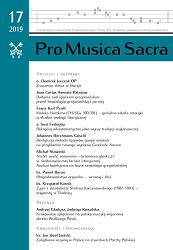Restytucja melodii śpiewów gregoriańskich na przykładzie nowego wydania Graduale Novum
Melodic restitution of Gregorian chants based on the new edition of Graduale Novum
Author(s): Johannes Berchmans GöschlSubject(s): Christian Theology and Religion, Music, Semiology, Hermeneutics, History of Art
Published by: Wydawnictwo Naukowe Uniwersytetu Papieskiego Jana Pawła II w Krakowie
Keywords: semiological orientation; adiastematic manuscripts; diastematic manuscripts; fraesological accent; protus; verbal articulation; Vatican edition; cantatorium; litterae significativae;
Summary/Abstract: Without any doubt the Graduale Romanum of 1908 (GR 1908) was a pioneer work of the highest order. Concerning the quality of its melodies this edition transcends by far the level of all previous editions. On the other hand the GR 1908 is far from being a perfect book. Especially if one examines the GR 1908 from the perspective of semiology, one will be faced with many discrepancies between the melodic version of the GR 1908 (and consequently of the Graduale Triplex) and the paleographical data and their semiological findings. So, for instance, a look at the introit Si iniquitates has shown, that the question of whether a piece in the third mode appears with tenor si (according to the oldest manuscripts and the Graduale Novum) or with tenor do (according to the GR 1908) is not insignificant for the expressive substance of this piece. Furthermore, the necessity of a correction of the melodic version of the the GR 1908 is not measured by the number of notes in need of correction, as it may be observed for example in several passages of the introit Resurrexi of Easter Sunday. Quite often a single altered note is enough to change completely the modal structure and the expressive substance. Even if someone examines in the Gregorian chants the connection between word and note at a semantic level can not avoid the question of whether the melodic version of the GR 1908 corresponds to an older or a more recent tradition, as it may be shown for example by a comparison between two correspondent passages of the introits Spiritus Domini and Victricem. Consequently, the restitution of the melodies of the GR 1908, as it has been realized by an international workgroup „Melodierestitution“ and published in the two volumes of Graduale Novum (Regensburg–Città del Vaticano 2011 and 2018), was necessary. Concerning the methodology of the melodic restitution, the fundamental principle was from the beginning the following one: The starting point and the highest authority for any work on the restitution of Gregorian melodies are the oldest adiastematic manuscripts of the tenth century, especially Cantatorium St. Gall 359, Laon 239 and Einsiedeln 121. And the most important task consisted in the search for as close as possible a melodic correspondence to the data of the adiastematic manuscripts. For this, the consultation and study of the most important diastematic sources, above all of Benevent 34 and Paris B.N. lat. 776 (Albi), is necessary. The total number of all the manuscripts consulted by the workgroup up to our days comes to about one hundred fifty. For other themes concerning the question of the melodic revision of the GR 1908, please, see: Johannes Berchmans GÖSCHL, Graduale Novum. Editio magis critica iuxta SC 117 – Kommentar, Regensburg 2018.
Journal: Pro Musica Sacra
- Issue Year: 17/2019
- Issue No: 17
- Page Range: 81-101
- Page Count: 21
- Language: Polish

